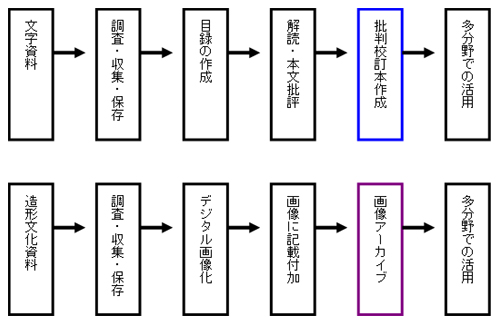予稿集 ※ 一部を除き、英語のみ
青柳 正規 / あおやぎ まさのり
【日本語】 > 英語
人文学におけるアナログ情報とディジタル情報
ある時代、文化、社会の復元、つまり文化相の再構築には、これまで文字資料(碑文、文書、文献等)を中心とした継時的研究diachronic studyによって文化相の生成や変遷の過程が明らかにされてきた。「記述」という継時性を本質的に内在する文字資料に基づく研究であるから当然の帰結である。しかし、ある特定の時点において、歴史的個体は継時性のもとにあると同時に共時的な空間のなかにおかれている。本質的に共時的であるモノ資料は共時的研究synchronic studyの中核的資料となりうるが、膨大な数の資料をアナログ画像によって行うことは不可能である。しかし、最近の情報処理の発達によってディジタル画像であればこの課題を克服することが可能となった。画像アーカイヴ構築の目的は、共時的研究を推進するための基盤構築なのである。ただし、共時的という空間性を復元しうる一方で、静態的となるおそれがあり、従来の文字資料を中心とする継時的研究の成果を活用することも重要である。
以上の研究を進めるに際して注意すべきは、ディジタル画像の保存と真正性に関する問題の解決には文書・文献等のアナログ資料の保存法と研究法を参考に、ディジタル資料を対象とする資料学を構築するということである。つまり、造形資料や碑文に関しては考古学・美術史・碑文学があり、その保存整理については博物館学がある。また古文書に関しては古文書学があり、保存整理等については文書館学が確立されている。この状況を表にするなら以下のようになる。
| 資料 | 資料学 | 保存整理学 |
| 造形物、碑文等 | 考古学、美術史学、碑文学 | 博物館学 |
| 古文書 | 古文書学 | 文書館学 |
| 文献 | 文献学 | 図書館学 |
もしディジタル資料を古文書や文献のように永続的に長期間使用するのであれば、ディジタル資料を対象とする資料学、保存整理学の分野を確立することが肝要であり、それらが確立するまでは、これまでの資料学、資料保存学を活用したディジタル文献学、ディジタル図書館学のような過程段階としての分野を育成することが必要であり、図表2のような資料操作の活用までの段階を明確にすることも重要である。そして最後に、ディジタル情報は記録媒体の脆弱性をつねに認識しておくことが必要であり、できることなら従来の印刷物による記録保存も平行して行うことが望ましいのではないかと筆者は考える。
 図表2 文字資料と造形文化資料の学術上の操作比較
図表2 文字資料と造形文化資料の学術上の操作比較
【英語】 > 日本語
Analogue and Digital Information in the Humanities
Reconstruction of certain time periods, cultures, and societies, in other words, reconstruction of various cultural aspects has largely depended upon diachronic study to reveal how such cultural aspects came to exist and/or changed through time by studying texts written in the forms of epigraphy and documents. Such reconstruction is bound to be diachronic since it is based on written materials, and "writing" as a human action is essentially diachronic. Yet, historical artifacts created at a certain point of time and space can be interpreted not only as diachronic but also synchronic existence, as they occupy space. Such artifacts, essentially synchronic in nature, can constitute the most crucial research materials for synchronic study, but it was impossible to study vast numbers of them as analogue images. However, this was changed by their digital images-a result of recent development of information technology. In this sense, image archiving can greatly contribute to establishment of synchronic study's firmer infrastructure. Although synchronic study can reconstruct the spatiality, it may have possibility to be static. Thus, it is important to supplement the synchronic study with the diachronic study's research outcomes, based on conventional written texts.
When we conduct this kind of study, we need to establish a methodology to study specific research materials (shiryo-gaku) and information science for their conservation and management, in this case, digital materials. Digital-specific ones, ought to be concerned about digital images' conservation and authenticity, a great deal of which could be learned from how its counterparts-the methodology and information science specialized for analogue materials such as texts and documents-have dealt with their conservation and established their ways to study the materials. To put it differently, archaeology, art history, and epigraphy have their own methodologies established to study artifacts and epigraphy, and for their conservation and management we have museum studies. As for ancient documents, paleography studies them, and archive science (archival studies) is to conserve and manage the documents. The following Table 1 shows what I just elucidated:
| Research Materials | Methodology to Study Research Materials | Information Science for their Conservation and Management |
| Artifacts, Epigraphy | Archaeology, Art History, and Epigraphy | Museum Studies |
| Ancient documents | Paleography | Archive Science (Archival Studies) |
| Documents | Philology | Library Science |
Like ancient documents and texts, if we are going to use digital materials continuously over an extended time period, we need to establish both methodology and information science, specialized for them. Until their establishment, however, we had better take provisional measures. That is, we have to develop and make the best use of digital philology and digital library science, based on the conventional philology and library science. We also have to clearly set every step of academic procedures to handle digital materials as Table 2 shows. Finally, we have to remind ourselves constantly of digital information's vulnerability as recording media, which leads me to believe that it is better to rely on both media, digital and conventional print, to record and conserve research materials of any cultural aspects, if possible.
 Table 2 Comparison of Texts and Artifacts as Research Materials and Respective Academic Procedures to Handle Them
Table 2 Comparison of Texts and Artifacts as Research Materials and Respective Academic Procedures to Handle Them